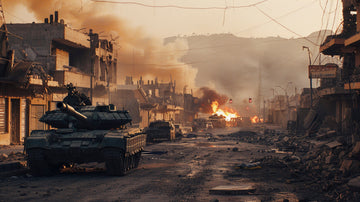Disasters don't wait for you to be ready. Whether you're facing floods, blackouts, or wildfires, having a plan and the right gear can save lives. Europe is not immune to crisis, and the past few years have proven how quickly things can change.
This guide breaks down the three most common emergencies across Europe and how to stay prepared with the right tools and knowledge.
1. Flooding
High-risk areas: Germany, Netherlands, Belgium, France, and Eastern Europe
Floods are the most frequent and damaging natural disaster in Europe. In recent years, climate-driven flash floods have taken lives and destroyed entire communities. Even one night of intense rainfall can overwhelm infrastructure and lead to mass evacuations.
How to prepare:
- Store important items above ground level
- Keep a waterproof 72 Hour Emergency Kit nearby with a dry bag, poncho, 5L folding water container, and hand crank radio
- Plan multiple evacuation routes
- Make sure your home insurance includes flood protection
What to do during a flood:
- Move to higher ground quickly
- Never drive or walk through moving water
- Turn off electricity if it’s safe
- Stay tuned to official broadcasts using a crank or solar radio
2. Power Grid Failures
High-risk areas: All of Europe, especially during winter storms or extreme summer heat
Power outages are no longer rare. Between cyberattacks, unstable energy supply, and aging infrastructure, blackouts can happen with little notice and last several days. Without power, you lose heat, food preservation, communication, and access to critical information.
How to prepare:
- Keep a 72 Hour Emergency Kit with essentials like USB light, soap sheets, glow sticks, and thermal sleeping gear
- Use a hand crank radio for updates
- Stock 2 liters of water per person per day
- Use rechargeable or solar lights instead of candles
- Set up a contact plan with family in case networks go down
What to do during a blackout:
- Preserve battery life on phones
- Avoid opening the fridge to keep food cold
- Stay informed using your emergency radio
- Check on neighbors, especially elderly or vulnerable people
3. Wildfires
High-risk areas: Greece, Portugal, Spain, Italy, Croatia, France, and increasingly Central Europe
With hotter, drier summers, wildfires are becoming more destructive. Even if your home isn't directly threatened by flames, smoke and infrastructure damage can be life threatening. Quick evacuation is often required.
How to prepare:
- Know local fire risk levels and escape routes
- Store face masks to reduce smoke inhalation
- Keep a packed 48 Hour Emergency Kit in your car or hallway
- Use a dry bag to protect critical documents and electronics
- Be ready to evacuate with your pet or child using add-ons like Pet Emergency Add-On or Child Add-On
- What to do during a wildfire:
- Evacuate early, before roads are closed
- Wear a mask and protective layers
- If trapped, stay low and find a clearing or body of water
- Listen to fire department instructions via radio
One Kit Can Make All the Difference
You cannot predict disaster. But you can prepare for it. Resceukit makes it simple with modular kits for 24, 48, or 72 hours. Each kit is built with the EETOM system — covering Essentials, Electronics, Tools and Utility, Outdoors, and Medical — so you know you're covered.
